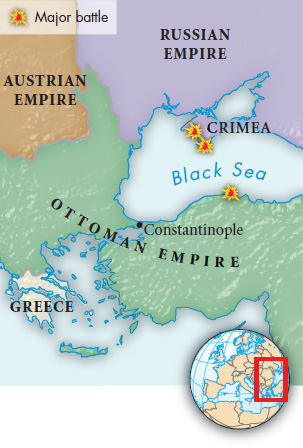A History of Western Society: Printed Page 764
A History of Western Society, Value Edition: Printed Page 772
The “Great Reforms” in Russia

In the 1850s Russia was a poor agrarian society with a rapidly growing population. Almost 90 percent of the people lived off the land, and industrialization developed slowly. (See “Living in the Past: Peasant Life in Post-Reform Russia.”) Bound to the lord from birth, the peasant serf was little more than a slave, and by the 1840s serfdom had become a central moral and political issue for the government. The slow pace of modernization encouraged the growth of protest movements, from radical Marxists clamoring for socialist revolution to middle-class intellectuals who sought a liberal constitutional state. Then a humiliating Russian defeat in the Crimean War underscored the need for modernizing reforms.
The Crimean War (1853–1856) grew out of the breakdown of the European balance of power established at the Congress of Vienna (see “The European Balance of Power” in Chapter 21), general Great Power competition over the Middle East, and Russian desires to expand into the European territories of the Ottoman Empire. An immediate Russian-French dispute over the protection of Christian shrines in Jerusalem sparked the conflict. Famous for incompetent leadership on all sides, the war revealed the awesome power of modern weaponry, particularly artillery, in ways that anticipated the U.S. Civil War. Massive naval engagements, doomed cavalry charges, and staggering casualties — Russia alone lost about 450,000 soldiers — captured the imagination of home-front audiences, who followed events in the national press. By 1856 France and Great Britain, aided by the Ottoman Empire and Sardinia, had decisively defeated Russia.
The war convinced Russia’s leaders that they had fallen behind the industrializing nations of western Europe. At the very least, Russia needed railroads, better armaments, and military reform to remain a Great Power. Moreover, the disastrous war raised the specter of massive peasant rebellion, making reform of serfdom imperative. Military disaster forced liberal-leaning Tsar Alexander II (r. 1855–1881) and his ministers along the path of rapid social change and modernization.
In a bold move, Alexander II abolished serfdom in 1861. About 22 million emancipated peasants received citizenship rights and the chance to purchase, on average, about half of the land they cultivated. Yet they had to pay fairly high prices, and because the land was to be owned collectively, each peasant village was jointly responsible for the payments of all the families in the village. Collective ownership made it difficult for individual peasants to improve agricultural methods or leave their villages. Thus old patterns of behavior predominated, limiting the effects of reform.
Most of Alexander II’s later reforms were also halfway measures. In 1864 the government established a new institution of local government, the zemstvo. Members of this local assembly were elected by a three-class system of townspeople, peasant villagers, and noble landowners. A zemstvo executive council dealt with local problems. Russian liberals hoped that this reform would lead to an elected national parliament, but it did not. The zemstvos remained subordinate to the traditional bureaucracy and the local nobility. In addition, changes to the legal system established independent courts and equality before the law. The government relaxed but did not remove censorship, and somewhat liberalized policies toward Russian Jews.
Russian efforts to promote economic modernization proved more successful. Transportation and industry, both vital to the military, were transformed in two industrial surges. The first came after 1860, when the government encouraged and subsidized private railway companies. The railroads enabled Russia to export grain and thus earn money to finance further development. Industrial suburbs grew up around Moscow and St. Petersburg, and a class of modern factory workers began to take shape. Industrial development and the growing proletariat class helped spread Marxist thought and spurred the transformation of the Russian revolutionary movement after 1890.
Strengthened by industrial development, Russia began seizing territory in far eastern Siberia, on the border with China; in Central Asia, north of Afghanistan; and in the Islamic lands of the Caucasus. The rapid expansion of the Russian empire to the south and east excited ardent Russian nationalists and superpatriots, who became some of the government’s most enthusiastic supporters. Alexander II also suppressed nationalist movements among Poles, Ukrainians, and Baltic peoples on the western borders of the empire.
Alexander II’s political reforms outraged reactionaries but never went far enough for liberals and radicals. In 1881 a member of the “People’s Will,” a small anarchist group, assassinated the tsar, and the era of reform came to an abrupt end. The new tsar, Alexander III (r. 1881–1894), was a determined reactionary. Nevertheless, from 1890 to 1900 economic modernization and industrialization surged ahead for the second time, led by Sergei Witte (suhr-GAY VIH-tuh), the tough, competent finance minister from 1892 to 1903. Inspired by the writings of Friedrich List (see “Government Support and Corporate Banking” in Chapter 20), Witte believed that industrial backwardness threatened Russia’s greatness. Under his leadership, the government doubled the network of state-owned railways to thirty-five thousand miles. Witte established high protective tariffs to support Russian industry, and he put the country on the gold standard to strengthen Russian finances.
Witte’s greatest innovation was to use Westerners to catch up with the West. He encouraged foreigners to build factories in Russia, believing that “the inflow of foreign capital is … the only way by which our industry will be able to supply our country quickly with abundant and cheap products.”1 His efforts to entice western Europeans to locate their factories in Russia were especially successful in southern Russia. There, in eastern Ukraine, foreign entrepreneurs and engineers built an enormous and very modern steel and coal industry. In 1900 peasants still constituted the great majority of the population, but Russia was catching up with the more industrialized West.